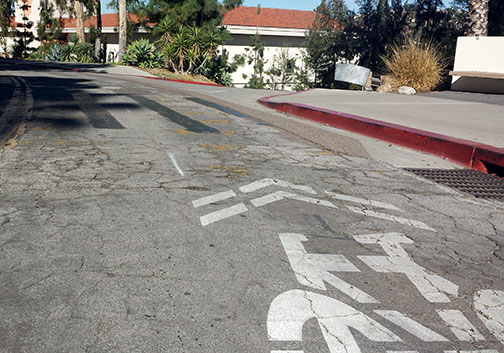Two-dozen engineering students from San Diego State and University of California, San Diego are being hired by the city to assess the state of its sidewalks.
The students will walk approximately 5,000 miles of sidewalks in San Diego, using GPS devices to plot damaged areas. The study will begin in a few weeks and last for a year. San Diego City Council agreed in June to set aside $1 million for the study in the city’s 2014 budget.
With the study, the city is attempting to gauge the scope of the condition of its sidewalks and estimate the cost of possible repairs, Councilman Mark Kersey said.
“We’ve never done a city-wide sidewalk assessment,” Kersey said. “There’ve been smaller kinds that have happened from time to time, but we’ve never done something that assesses all 5,000 miles of sidewalk that the city has.”
The city’s sidewalks have fallen into disrepair in large part because the city is not legally responsible for sidewalk maintenance. Sidewalks are the property of the homes and businesses they border, yet the city is responsible for any accidents that happen as a result of hazardous sidewalks.
“It’s kind of a patchwork right now,” Kersey said. “We’ve got an interesting legal situation where the property owner, whether it’s a household or a business, is responsible for the maintenance of a sidewalk in front of their property. However, if someone were to trip and fall and hurt themselves, the legal liability falls to the city.”
As a result, sidewalk maintenance has been done primarily in response to complaints. Sometimes sidewalk repair only entails the use of black asphalt rather than concrete poured on the ground to smooth over an uneven surface.
Voice of San Diego maintains a site called The Stumbler dedicated to documenting San Diego’s worst sidewalks with photos.
In response to deteriorating sidewalks, the city’s infrastructure committee, chaired by Kersey, is in the process of reviewing the city’s sidewalk policies.
“Sidewalks are a long neglected component of our infrastructure, and it’s a big quality of life issue,” Kersey said. “In some parts of town you’ve got no sidewalks and neighborhoods that have wanted one for decades and have just never gotten one.”
The city has a cost-sharing program that splits the cost of sidewalk repair 50/50 with a property owner. This program has been underutilized in the past, though it has seen an uptick in users this year, Kersey said.
Engineering students hired for the sidewalk assessment will gain experience in the field and help keep the city’s costs low, Kersey said.
Currently, the students are undergoing background checks before they are employed, and the study is expected to begin by mid-December, Transportation and Storm Water Supervising Public Information Officer Bill Harris said.
Sidewalks are just one aspect of wider concern for the city’s neglected infrastructure. Budget constraints have caused the city to backlog about $898 million in streets, facilities and storm drain projects, according to a March 2013 report from the budget analyst’s office.
Photo by Wesley Beights, staff photographer







